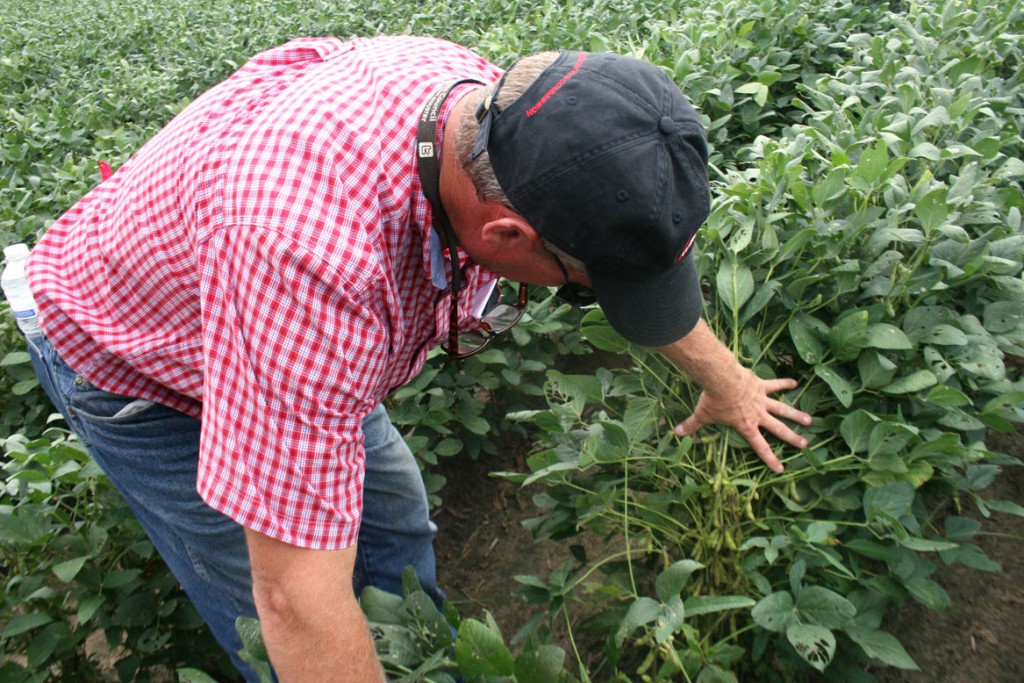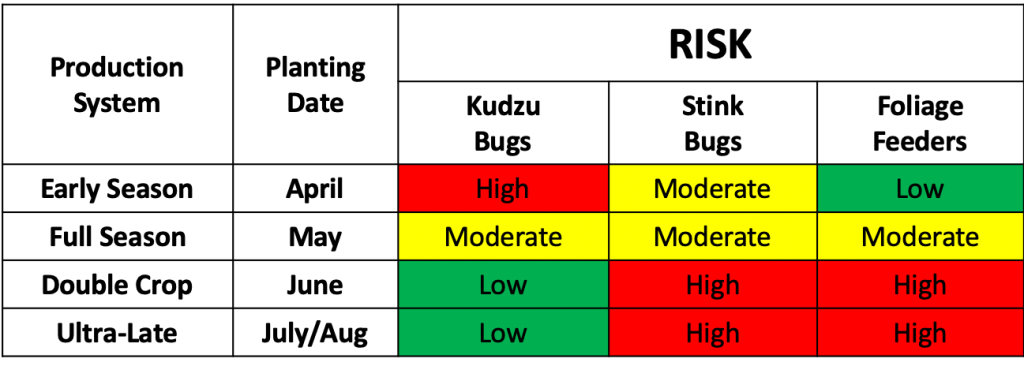Written By: Emily Cabrera, IPM Communications Coordinator
Expert Source: Phillip Roberts, Extension Entomologist

In 2019, soybeans were planted on 100,000 acres in Georiga. At this month’s Northeast Georgia Soybean Production Meeting in Bowman, University of Georgia Extension specialists provided updates for growers going into the 2020 season.
Extension entomologist Phillip Roberts provided the insect pest management update for growers and stressed the importance of starting the season weed-free to minimize pest establishment and understand thresholds to determine when and if control measures need to be taken.
“Soybeans are typically a ‘low-spray’ crop for insect pests” said Roberts, “however, there are times when growers may need to use an insecticide application in order to protect crop yields, but be mindful that when using broad-spectrum insecticides, beneficial insects will be impacted as well.”
Roberts indicated that Georgia producers plant soybeans from April through July and suggested that insects are generally less of a problem on early planted soybeans, “the later you plant the more likely you are to have problems with insects, especially stink bugs and caterpillars” he said.

One exception to this rule would be kudzu bugs, which are more problematic on early planted soybeans; however, intervention with insecticides has not been needed in recent years because of two naturally occurring biological controls present in the environment. The fungus Beauveria bassiana infests kudzu bugs and has a high mortality rate, which keeps this pest below threshold for soybeans.
“And if the fungus doesn’t kill them, the parasitic wasp Paratelenomous saccharalis may,” said Roberts. “Data show this wasp can kill up to 50% of a population.” Recommendations for management of kudzu bugs are to focus on the immature stages of this pest’s development, scout for small green bugs on the stems of beans, and if populations exceed one immature kudzu bug per sweep or if immatures are easily and repeatedly found on main stems an insecticide is recommended. In most situations, a single well-timed insecticide application will provide acceptable control of kudzu bugs for the remainder of the season.
One of the most important tasks for a grower should be making time for insect pest scouting. “An ounce of prevention is worth a pound of cure” as the saying goes. Roberts suggests scouting should begin at emergence and continue until soybeans are mature. Sweep nets and drop cloths are useful scouting tools for counting and proper identification.
“A number of insect pests are capable of severely damaging soybeans; however, soybeans can withstand considerable insect damage at certain times without economic yield loss,” said Roberts. Management strategies for protecting soybean yield are most effective when you are able to identify the growth stage in which potential yield is affected.
Seedling Pests
Growers should monitor for seedling pests until the plants are 12 inches tall. Look for insects on the plant or in the soil around the base of plants. Evaluate stand loss (% of dead or dying plants) and try to determine if future stand loss is probable (insects present and actively damaging plants).
“In hot, dry conditions, lesser corn stalk borer can become a major issue in establishing a good stand. The larvae feed underground, so if you dig around wilting or dying seedlings, you may see evidence of this pest by the silk tubes,” explained Roberts. Other potential seedling pests in soybeans are grasshoppers, false chinch bug, three-cornered alfalfa hopper, sugarcane beetle, cutworm.
Foliage Feeders
Throughout the season, determine what insects are feeding on the foliage and how much defoliation they are causing. The decision to treat foliage feeders may be based on the growth stage and defoliation.
“Prior to bloom foliage feeders should be controlled when defoliation reaches 30 percent, after bloom treat when defoliation reaches 15 percent,” said Roberts. Defoliation thresholds are based on whole plant foliage loss. Major foliage feeders in soybeans are soybean looper, green cloverworm, and velvetbean caterpillar. Other potential foliage feeding insect pests include beet armyworm, grasshopper, bean leaf beetle, japanese beetle, blister beetle, and saltmarsh caterpillar.

Roberts recommends using Dimilin at the R2 – R3 stages in areas where foliage feeding caterpillars are commonly observed. R2 is when there is an open flower at one of the two uppermost nodes, with a fully developed leaf. R3 is when pods are 3/16 inch (5 mm) at one of the four uppermost nodes.
“You should apply Dimilin at a rate of 2 ozs/acre, which will control green cloverworm and velvetbean caterpillar, and will suppress soybean looper and young grasshoppers. This has a long residual, but be careful not to apply too early, because new growth will not be protected” explained Roberts.
“And don’t forget the stinkbugs!” cautioned Roberts. Stinkbugs are the number one insect pest in soybean production. Brown stink bug, green stink bug and southern green stink bug are common pests in soybeans in Georgia. These are typically “edge feeders” initially but will eventually infest entire fields. The most damaging period is during pod fill, not only causing physical damage but also create an entry site for pathogens to be introduced. Damage results in unfilled, malformed or shrunken pods, and even aborted pods. Stink bugs develop from egg into adult between 35 – 40 days.